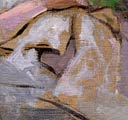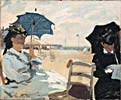Claude Monet composing
Virginia Spate writes like Monet paints, and
this could equally have been written about the ’Garden scene’: “The
painting, ‘In the Norvègienne’, is composed in scales of closely
related colours… Although these colours convey the subjective
impression of the fragile moment, they are so abstracted that they
no longer indicate imminent change. The intensely still painting
suggests a prolonged moment which will never end.”, (Spate: Claude
Monet, The Colour of Time, p.187.)
Let us continue and try to
find out how Monet arranged the idyll of the ‘Garden scene’, and
compare it to some other paintings.
The
left wing is built up by the round shape of the chair, and by
the bushes, with the leaves like a curtain behind.
-> Click for details |

Click picture for details |
The
oval shape of the table gives an impression of depth, and forms
the right wing of the scene.
See also how the table is cut off by the edge. |
The
right hand side outline of the skirt goes directly to her eyes.
From her eyes, our eyes will continue to the ‘needle’ in her
hand.
-> Click for details |
If we follow the
left leg of the table, we end up in the center 'needle point'.
-> Click for details |
We can easily find out how carefully Monet
calculated his compositions. When we take the measurements of the
painting and in this way find out were the exact central point of
the picture is, we will find that it is exactly were the needle in
her hand is. This also remains the focus for her concentration and
for our eyes. More about this soon…
The Claude Monet 'looking through' effect
Let us have a closer look at what we are
calling the ‘looking through’ phenomenon. The gravel walk continues
further on into the garden, behind the model. Please note how we can
‘look through’ the model. We are able to see the gravel walk even
under the cloth, she is working with. (Click detail to the
right.)
 This
is strengthening the 3-D effect in the painting, and is an important
detail, so very typical for Monet. We are able to look through the
models, rocks, vaults of bridges, tree trunks, foliage and whatever
Monet chose to paint. The purpose is obvious. Monet creates and
strengthens the depth dimension by choosing angles from which you
can see through the models etc. The small details that seem so
unimportant, turn in fact out to be very important indeed, and
again, certainly are not there by coincidence! This
is strengthening the 3-D effect in the painting, and is an important
detail, so very typical for Monet. We are able to look through the
models, rocks, vaults of bridges, tree trunks, foliage and whatever
Monet chose to paint. The purpose is obvious. Monet creates and
strengthens the depth dimension by choosing angles from which you
can see through the models etc. The small details that seem so
unimportant, turn in fact out to be very important indeed, and
again, certainly are not there by coincidence!
Unfortunately much of the
effect of this way of creating the perspective in the ‘Garden-scene’
has been destroyed. The canvas was once varnished. This varnish
turned brown by old-age. Unfortunately it has not yet
been possible to remove it from the parts of the
cloth, that was left uncovered by paint. We can only imagine how the
painting once looked like, when the colour
of the canvas played it’s original part in
the ensemble of the colours. This way of leaving part of the canvas
unpainted, and letting its own colour perform with the others, is
indeed very typical for Monet. For his way of working,
for his technique, and for the elaboration of the canvas.

The beach at
Trouville
Another example of this we
find in: ‘The
beach at Trouville’, 1870, (W158), chosen here only because
of the similar scene. (The hand of the sewing women is left
unpainted – to be compared with our unpainted cloth). In this
painting we also find a good example of ‘looking through – objects’,
with the effect this ‘trick’ renders to the picture. Take a small
piece of paper and cover the chair back and you will understand the
important part it really plays! The 3D - effect disappears, the
figures look like cut paper silhouettes!
Next we shall
have a glimpse at some other works that come close to our ‘pochade’,
because that is what it is. Do not forget this fact when
comparing with finished canvases, signed and sold by the artist.
Much of the
nerve, the impression, we find in the ‘Pochade’, has often
disappeared in the finished painting. The ‘impression’ of the short
moment, caught by Monet in front of the motif, is often lost. This
due to the fact that he continued to work on his canvases over
several days, when the right circumstances appeared. Later they were
sometimes reworked in the atelier, and the brush work became less
strong.
Press HERE for next
page
|